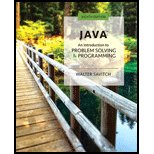
Write a
- Use scanner to read a floating-point value x.
- Compute 1.0 I x and store the result in y.
- Display x, y, and the product of x and y.
- Subtract 1 from the product of x and y and display the result.
Try your program with values of x that range from 2e−11 to 2ell. What can you conclude?
Program Plan:
- • Include the required header files.
- • Define main function.
- ○ Create an object for scanner.
- ○ Get the floating-point value from the user.
- ○ Calculate the “y” value.
- ○ Display “x”, “y” and product of “x” and “y”.
- ○ Subtract “1” from product of “x” and “y” and then display the result.
The program is used to read a floating point value then compute “y” and display “x”, “y”, product of “x” and “y” and also subtract “1” from product of “x” and “y” then display the result as follows:
Explanation of Solution
Program:
//include required header files
import java.util.Scanner;
//definition of "Approximation" class
public class Approximation
{
//definition of main method
public static void main(String[] args)
{
//create an object for scanner
Scanner keyboard = new Scanner(System.in);
//declare the required variable
float x = 0, y;
//get the input from the user
System.out.println("Enter a floating point value.");
x = keyboard.nextFloat();
//calculate "y" value
y = (float) (1.0/x);
//display "x" and "y" value
System.out.println("x value is: "+ x);
System.out.println("y value is: "+ y);
//display product of "x" and "y"
System.out.println("Product of x and y is: "+ (x*y));
/*subtract 1 from product of "x" and "y" and display the result*/
System.out.println("The difference of x*y and 1 is " + ((x*y) - 1.0));
}
}
Conclusion:
The “x” depends on user but the product of “x” and “y” will always give “1” and difference of “x * y” and “1” is always “0” because, “1” is divided by “y” and then “y” is multiplied with the “x”. So there is no change in product of “x” and “y” and difference of “x * y” and “1”.
Output:
Enter a floating point value.
2.5
x value is: 2.5
y value is: 0.4
Product of x and y is: 1.0
The difference of x*y and 1 is 0.0
Want to see more full solutions like this?
Chapter 2 Solutions
Java: An Introduction to Problem Solving and Programming (8th Edition)
Additional Engineering Textbook Solutions
Java How to Program, Early Objects (11th Edition) (Deitel: How to Program)
Introduction To Programming Using Visual Basic (11th Edition)
Starting Out with Java: From Control Structures through Objects (7th Edition) (What's New in Computer Science)
Starting Out With Visual Basic (8th Edition)
Concepts Of Programming Languages
- "Do not use AI tools. Solve the problem by hand on paper only and upload a photo of your handwritten solution."arrow_forwardSolve this "Do not use AI tools. Solve the problem by hand on paper only and upload a photo of your handwritten solution."arrow_forwardSolve this "Do not use AI tools. Solve the problem by hand on paper only and upload a photo of your handwritten solution."arrow_forward
- Specifications: Part-2Part-2: DescriptionIn this part of the lab, we will illuminate two 7-segment displays. You will need to understand 2's Complement todetermine when the input 4-bit binary number corresponds to a negative or positive number. To understand how anLED display works in Digital, please refer to the playWithLED_Display.dig file provided. You should play withdifferent input combinations to see how it influences the LED Display value. In the screenshot below, note how I wasable to generate the display of “3” on the Hex display by lighting up only certain input wires to the unit. Here is a picture of how the different segments light up to produce the different displays: Note in the picture above that we showed displays only from 0-8 since in 4-bit 2s complement representation, 8 is thelargest modulus value you can represent (the range of integers would be -8 to +7).Your circuit in Part-2 must accept a 4-bit 2's complement input {in3, in2, in1, in0} where in3 is the most…arrow_forwardSolve this "Do not use AI tools. Solve the problem by hand on paper only and upload a photo of your handwritten solution."arrow_forwardSolve this "Do not use AI tools. Solve the problem by hand on paper only and upload a photo of your handwritten solution."arrow_forward
- Solve this "Do not use AI tools. Solve the problem by hand on paper only and upload a photo of your handwritten solution."arrow_forwardSolve this "Do not use AI tools. Solve the problem by hand on paper only and upload a photo of your handwritten solution."arrow_forwardSolve this "Do not use AI tools. Solve the problem by hand on paper only and upload a photo of your handwritten solution."arrow_forward
- Solve this "Do not use AI tools. Solve the problem by hand on paper only and upload a photo of your handwritten solution."arrow_forwardSolve this "Do not use AI tools. Solve the problem by hand on paper only and upload a photo of your handwritten solution."arrow_forwardSolve this "Do not use AI tools. Solve the problem by hand on paper only and upload a photo of your handwritten solution."arrow_forward
 C++ Programming: From Problem Analysis to Program...Computer ScienceISBN:9781337102087Author:D. S. MalikPublisher:Cengage Learning
C++ Programming: From Problem Analysis to Program...Computer ScienceISBN:9781337102087Author:D. S. MalikPublisher:Cengage Learning C++ for Engineers and ScientistsComputer ScienceISBN:9781133187844Author:Bronson, Gary J.Publisher:Course Technology PtrProgramming Logic & Design ComprehensiveComputer ScienceISBN:9781337669405Author:FARRELLPublisher:Cengage
C++ for Engineers and ScientistsComputer ScienceISBN:9781133187844Author:Bronson, Gary J.Publisher:Course Technology PtrProgramming Logic & Design ComprehensiveComputer ScienceISBN:9781337669405Author:FARRELLPublisher:Cengage EBK JAVA PROGRAMMINGComputer ScienceISBN:9781337671385Author:FARRELLPublisher:CENGAGE LEARNING - CONSIGNMENT
EBK JAVA PROGRAMMINGComputer ScienceISBN:9781337671385Author:FARRELLPublisher:CENGAGE LEARNING - CONSIGNMENT Microsoft Visual C#Computer ScienceISBN:9781337102100Author:Joyce, Farrell.Publisher:Cengage Learning,
Microsoft Visual C#Computer ScienceISBN:9781337102100Author:Joyce, Farrell.Publisher:Cengage Learning,




